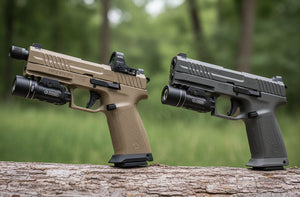One thing Walther and Canik have in common is that both actually listen to their shooters. That’s a big deal in times like these, where product reviews matter so much.
They will pop up almost everywhere: Walther vs. Canik comparisons in videos, on forums, and at the range. Yet, what still surprises us at 45 Blast is the “clone” story. For some reason, people still bring it up even after more than 20 years of Walther and Canik following very different paths.
Right now, the “Canik copied Walther” claim is missing the point. Yes, Canik drew inspiration from Walther in the early TP9 days. But now, each company has carved its own place in the striker-fired pistol arena, with innovations for accuracy, reliability, and pricing strategies.
So let’s clear up the doubts and see how Walther and Canik stack up today. What’s old, what’s new? We’ll compare accuracy, recoil, handling, and overall performance, even with some model matchups. Gear up, because this is going to be a head-to-head.
Brand Overview: Canik vs Walther
When Canik first stepped into the U.S. market, they knew exactly who one of their natural competitors would be: Walther. Both brands put innovation front and center, listen to shooters, and build firearms with a military-grade edge.
They sure come from very different places, but they share a surprising amount in common.
Walther’s story goes way back. Founded in Germany in 1886, they started as rifle makers, but in 1929 they dropped a true game-changer, the Walther PP. That pistol introduced features we now take for granted: a DA/SA trigger, loaded chamber indicator, hammer-drop safety, and slick ergonomics.
All those ideas carried through to modern classics like the PPQ and PDP. By 2012, Walther set up in Fort Smith, Arkansas. Just a few years later, they started producing pistols right here in the U.S.
Canik’s path is different. The company was born in 1998 in Turkey as an aerospace and defense contractor working with Boeing and Airbus. They made the jump into firearms in 2005 with the Canik 55, a sidearm adopted by Turkish law enforcement. By the early 2010s, Canik hit the U.S. market with the TP9 series: striker-fired pistols packed with premium features at competitive prices.
From there, it snowballed: NATO endorsement, collaborations with Salient Arms, Century Arms, and even Taran Tactical Innovations. In 2024, they went one step further and began producing pistols in West Palm Beach, Florida.
So, when people compare Canik vs Walther, they’re really talking about two different routes to a very similar destination: innovative, shooter-driven pistols that deliver on performance. And that’s where things start to get interesting.
Is Canik a Walther Clone?
The short answer is no, Canik is not a clone. Calling Canik a “Walther copy” misses the bigger story. Yes, they borrowed design cues and lessons from their German competitors early on with the first TP9’s. But really, a clone usually means zero innovation: a cheap replica that doesn’t add anything new. That’s not what happened.
The truth: Walther’s design and engineering innovations shaped the entire pistol market for decades. Canik took those lessons and doubled down on feature value: optics-ready slides, modern ergonomics, refined factory triggers, and attractive pricing without scrimping on quality.
Instead of simply copying, Canik evolved. They added features shooters asked for, pushing manufacturing and value in ways that forced established makers to respond.
Look back to the TP9s U.S. debut: shooters noticed familiar lines and a comfortable grip that called to mind the Walther P99. But most respected reviewers didn’t call it a knockoff. They called it impressive for the price.
A decade ago, when Apex Gunsmithing opened up the classic TP9 and compared it side by side with the P99, that was a true test. He found very similar mechanics and features, built for performance and reliability, at a much better value.
But again, that was more than ten years ago.
Today, both companies run full, modern lineups packed with original features. So let’s pair some Walthers against Caniks, side by side:
Canik vs Walther Model Matchup

Carry Pistols: Walther PPS vs Canik Mete MC9
If you want something tiny and reliable, both the PPS and Mete MC9 fit the bill. Slim, single-stack carry guns. Their barrel length is around 3.2 inches, and their width, about 1.1 inches. Both pistols weigh just under ~22 ounces unloaded.
With the Walther PPS vs Canik Mete MC9, you get slim grips, simple sights, and concealment-first designs right out of the box. These aren’t high-capacity race guns, but they’re deep-concealment workhorses. Comfortable to carry, easy to hide, and friendly in the hand.
Full Size Duty: Walther PDP, Canik METE SFX
This is where duty and range work meet. Both handguns have barrels in the 4–4.5" range and unloaded weights in the mid-20s ounces. That extra mass and sight radius make follow-ups and accuracy easier.
Both the Walther PDP and Canik METE SFX ship with modern ergonomics, interchangeable backstraps, optics-ready slides on many trims, accessory rails, and service-grade magazines. In short, they’re reliable, do-everything pistols built for serious use.
Competition Pistols: Walther Q5 vs Canik Rival S
Long slides, long sight radius, and built for speed. Barrel lengths push past 5", and with heavier frames for stability.
Both the Walther Q5 vs Canik Rival S are factory-ready for competition: optics-ready slides, tuned or excellent factory triggers, extended mags, and slide/lightening features that cut muzzle flip and speed follow-ups. Basically, race-gun features straight from the box.
Performance Comparison
Accuracy
When we check out most of the reviews about accuracy, we find the same story: Walther and Canik trade bullets at the same target. Groups are tight. Split times are fast. For example, both race guns here, the Walther Q5 and Canik Rival S, push hit factors in the 7.6–8.6 range.
Beyond a certain level, it’s more about the shooter than the gun. Plain and simple.
For everyday carry and non-comp pistols, the accuracy story still holds. Microcompacts like the Walther PPS and Canik Mete MC9 surprise a lot of people, as both can shoot accurate and fast. Specs won’t tell you that. Range time will.
Which pistol is more accurate? Try both a Walther and a Canik, and you’ll see: either one will let you be precise if you put in the work.
Recoil & Handling
Most side-by-side reviews focus a lot on ergonomics. Both brands look and feel premium. But there are differences
Walther nails refined grip geometry and smooth contours. That gives predictable recoil and a confident feel in the hand.
Canik matches that with modern grip designs and engineering that makes the pistols feel flat and controllable.
You’ll see comments like “the PDP is snappier.” That usually comes down to slide mass and timing more than a mistake in design. In microcompacts, the PPS and Mete MC9 both manage recoil very well, quite impressive for pocket-size guns.
And now that we are talking about this: We built on that with our Canik compensator line not as an afterthought, but as an extension of the gun. They fit clean, look right, and cut felt muzzle rise dramatically. For many shooters that’s the difference between “good” and “really fast.”
Trigger Performance
It's a given: we all know that triggers on Walthers and Caniks are the best ones that can come from stock. A poor trigger will hide otherwise-solid accuracy and handling. But we know that these two brands actually excel on this feature.
Out of the box, both Walther and Canik deliver excellent factory triggers: crisp breaks, clean stacks, consistent walls. You can shoot fast with either.
Where Canik often gets the nod is reset. Their resets are short across the lineup, compacts, full-size, competition models. Short reset equals shaved milliseconds on follow-ups. In a stage or tight drill, those milliseconds add up. So while Walther’s triggers are superb, Canik’s faster reset gives a practical edge for speed shooters.
Reliability & Durability
When you think about Walther, you think about German style reliability and durability. They are solid, well-designed, and built to put up with the hard work. After all, they started as police and duty use firearms.
Canik had to earn that same respect following a different path. Coming from Turkey, they proved themselves with NATO testing, industry partnerships, and how shooters who tried them, kept them for good.
That’s how today many shooters treat Canik and Walther in the same sentence for dependability. Check the forum talk about the PDP vs METE SFX, and that’s what you’ll see.
What do range tests show? Typical 600–1,000 round endurance runs for both brands come back clean more often than not. Beyond that, reports get anecdotal: user error, limp wristing, a bad mag here or there.
Real-world users frequently say things like “I’m at 3,000+ rounds with zero trouble,” and that’s common across both camps.
So when people ask about Canik vs Walther reliability, the honest answer is: both are extremely reliable. The main difference is legacy. Walther’s been trusted in the U.S. longer, so it carries history and familiarity. Canik had to prove itself, and it did so really fast.
Bottom line? Pick the model you like, run it hard, and it will hold up. Most shooters choose between them based on feel, features, and price. But what they know for sure is that no brand is inherently more durable than the other.
Now, when it comes to your wallet, that’s a different story.
Price & Value for Money
The money you save on a Canik often buys you more range time and more practice. And you’re not buying a stripped-down gun. This is the real package: crisp triggers, well-thought grips, decent stock sights, and features like optics-ready slides and extended mags that used to cost a premium. In short: real performance for less.
With Walther, while they’re not the priciest on the market, some of those features may not come standard right out of the box.
Here are typical new price ranges we often see in for the US market:
-
Microcompacts: Walther PPS: $450–$600 vs Canik Mete MC9: $380–$550
-
Full-size / Duty: Walther PDP: $540–$700 vs Canik METE SFX: $480–$560
-
Competition: Walther Q5: $830–$1,000+ vs Canik Rival S: $840–$970
In the end, your choice will come down to feel, features, and budget.
And if you want an even broader view, we’ve also compared other major brands in separate posts, like Canik vs Glock and Canik vs Sig Sauer. If you’re narrowing down a purchase, those two reads are a good call.
Should You Choose Walther or Canik?
How to choose? Try both at the range. Feel the grip. Test the trigger. Run a few drills. Forum talk is background noise. The pistol in your hand is the only opinion that matters.
Walther is the pick for folks who value German engineering and design. Smooth ergonomics. Polished triggers. Proven platforms trusted by police and competitors for years, like the PP and PDP.
Canik is the value-performance pick. Fast resets. Flat-shooting designs. Features packed in right out of the box. Rival S, METE SFX, and Mete MC9 give you cutting-edge tech without the sticker shock.
If you decide to go with the Canik, you know how to reduce recoil even further. At 45 Blast we built our comps to maximize those flat shooters. So go ahead and check out our pistol compensators here, and feel the difference on follow-ups.
All this said, whatever you pick, you’re in for some high-quality range time. Feel the grip, test the trigger, run a few drills. Decide at the range, where both of these great pistols belong.


